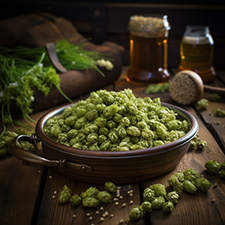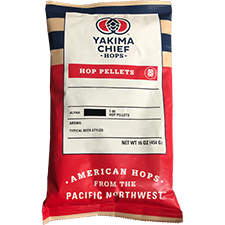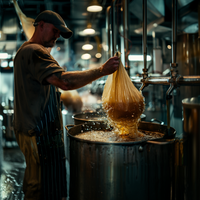What is Dry Hopping and Can You Use Hop Pellets?
Posted by Matteo Lahm on 9th Apr 2025
If you are a beer maker, you most likely have heard of dry hopping. If you've never tried it because you use hop pellets, you don't have to let that stop you. The simple truth is that dry hopping can add wonderful flavor nuances to your brews, and it works with pellets. There are some technical considerations so let's deal with the details.
To avoid any confusion and for the sake of being thorough, let’s clearly define what dry hopping is. It is a brewing technique that involves introducing hops to the beer after the fermentation process has taken place.
Now, you might be wondering, why add hops post-fermentation? Well, during the boiling phase of brewing, some of the terpenes that are responsible for the flavors and aromas boil out. This can cause your hops to lose some of their delicate floral and herbal notes, leaving behind a stronger, more bitter flavor. This can sometimes overpower the other characteristics of the beer. It's like adding too much hot sauce to a dish - you end up tasting only the heat and missing out on the other flavors.

By adding hops after fermentation, you're allowing these lighter, more nuanced flavors and aromas to shine through by allowing them to infuse into the beer. The result is a beer that has a more complex flavor profile, with the bitterness of the hops beautifully balancing the inherent sweetness of the malt. It's similar to adding a sprinkle of salt to caramel. The salt doesn't change the caramel's sweet flavor but instead enhances it, creating a more balanced and intriguing taste experience.
Sometimes, brewers even add hops during secondary fermentation, a slower, cooler fermentation phase that follows the initial, vigorous primary fermentation. This can further accentuate the beer's aroma and flavor, adding depth and complexity.
So, in essence, dry hopping is a technique that allows brewers to play with the flavor and aroma profiles of their beers, adding layers of complexity and making each sip a unique experience. It's a testament to the art and science of brewing, where a simple change in how you introduce an ingredient like hops can be manipulated in various ways to create a lot of flavor subtleties.
Now, onto the main event: pellets. These are not your average rabbit food pellets, but rather, they're the result of pressing hops into a more manageable form. Pellets are easier to store, transport, and work with, making them a favorite among brewers. And the best part? There's no significant difference in flavor, aroma, or quality between whole hop flowers and hop pellets.
But here's the catch: Can you dry hop with pellets? The answer is a resounding yes! However, there's a small hiccup. Pellets, being compressed bits of hop flowers, tend to disintegrate when added to liquid, potentially turning your brew into a sludgy mess. But don't worry, you’ve got an easy solution for that.
To avoid this messy situation, simply place your pellets in a fine nylon strainer bag. Then immerse the bag into your brew during secondary fermentation. After a few days, remove the bag, leaving your brew pellet-free but full of flavor and aroma. It's like making tea, but with beer!
Hops are a complex ingredient, containing a variety of compounds that contribute to the flavor and aroma of beer. Among these compounds are essential oils and alpha acids, but there are also beta acids present.
Alpha acids are the primary bittering agents in hops. When these acids are exposed to heat during the boiling process, they undergo a chemical reaction known as isomerization. This process transforms the alpha acids into iso-alpha acids, which are soluble in water and contribute to the beer's bitterness.
However, the boiling process can cause some of the more delicate flavors and aromas in the hops to evaporate. This is where dry hopping comes in. By adding hops post-fermentation, brewers can extract these flavors and aromas without the risk of them being lost to evaporation. It's a bit like adding fresh herbs to a dish after it's cooked to preserve their delicate flavors.

Now, onto beta acids. While less prevalent than alpha acids, beta acids also play a role in the beer's flavor profile. Unlike alpha acids, beta acids do not contribute to bitterness when the beer is fresh. However, they can oxidize over time, leading to an increase in bitterness. This is why beers with high beta acid content can become more bitter as they age.
In the context of dry hopping, beta acids are less significant than alpha acids and essential oils. This is because beta acids are less soluble in water and do not isomerize during the brewing process. However, they can contribute to the beer's aroma, adding another layer of complexity to the final product.
Dry hopping can be a bit of an art form, with the duration, temperature, and type of hops all playing a role in the final product. For instance, the extraction of compounds during dry hopping takes between 1 and 3 days, with the greatest extraction occurring within the first 24 to 36 hours. If you use a carboy for secondary, you might be wondering how you will fit a strainer bag into the spout and how you will get it out? It is a reasonable question. The solution is to add it at the very end of fermentation before you transfer. Considering the timeline, you will get the desired extraction during that last day to day and a half before you transfer it to a carboy. By then fermentation has calmed down significantly so you will not have those evaporation issues that diminish the nuances of the hops during your boil.
When it comes to temperature, the sweet spot is between 10 and 14 degrees Celsius (50 to 57.2 degrees Fahrenheit.) This helps to avoid 'hop creep', a phenomenon where hops release enzymes that transform dextrins into fermentable sugars, leading to a change in alcohol content and taste. So if your space is warmer than that, you may want to find a way to drop the temperature before you do it. An easy low tech solution is to set up a tub with ice water. Place your fermenter inside it and monitor the temperature. Once it hits the high end of the dry hopping temperature range, add your hops. When approaches the low end, take the fermenter out. If you make 5 gallon batches, it will likely take longer for it to warm back up to room temperature than the dry hopping process itself. If you are using a plastic fermenter, consider that plastic is a natural insulator which can make it take even longer.
Finally, the type of hops used can greatly influence the beer's flavor profile. Whether you're using cones or pellets, each form has its pros and cons. Cones offer natural extraction but can absorb more wort, leading to higher liquid loss. Pellets, on the other hand, dissolve for better extraction of components but can cloud the beer if a cold crash isn't performed post-dry hopping. If your beer never reaches the bottom temp during the dry hopping process and you are using the low-tech ice bath technique, just add more ice after you remove the hops to reach your desired cold-crash temperature.
In conclusion, dry hopping with pellets is not only possible but can also lead to some fantastic results. It's a technique that requires a bit of patience, creativity, and a good understanding of your chosen hop variety. But with a bit of practice, you'll be brewing beers with complex flavor profiles that will have your friends and family hopping for more!

